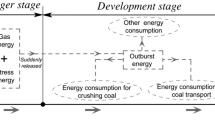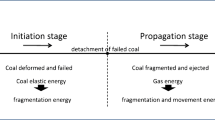Abstract
Coal and gas outburst is a dynamic disaster that poses a significant threat to coal mines. Energy analysis is an effective tool for understanding the mechanisms behind such outburst. The energy sources and dissipation during outbursts were explored using a multifunctional test system, and the energy transformation relationship was analyzed based on experimental results. Based on these, the crushing mechanism of outburst coal was further investigated. The results show that the adsorbed gas does not all participate in the work during an outburst. Thus, an effective desorption ratio was introduced to characterize quantitatively the percentage of volume of adsorbed gas involved in an outburst. The effective desorption ratios were calculated and found to be in the range of 5.07–13.36% under the test conditions and were primarily related to gas pressure and exhibited an exponential growth relationship. The energy of outbursts generally comes from gas expansion energy, which is 52.7 times that of the elastic strain energy. The gas expansion energy consists of adsorbed gas energy and free gas energy and accounts for 81.6–91.0% of the gas expansion energy, and it is the main energy source for continuous coal fragmentation and transport. The energy conversion of an outburst mainly occurs among gas expansion energy, coal crushing, and transport energy. The energy dissipation under high gas pressure conditions was found to be dominated by crushing energy, whereas under low gas pressure conditions, it was dominated by transport energy. The involvement of ground stress increased the breakage rate of the coal by 23%, whereas the breakage rate of the coal constantly increased with increase in gas pressure. The spatial distributions of the coal mass and crushing power in the roadway were consistent; however, the energy required in the initial stage of coal crushing was significantly larger than that in the middle and final stages. The release and consumption of energy during an outburst are processes of rapid decay from strong to weak. Finally, the processes of preparation, initiation, development, and termination of outbursts are described completely from the perspective of energy evolution, and the roles of ground stress and gas (free gas and adsorbed gas) during outbursts are clarified. The results provide reference ideas and theoretical basis for the accurate identification, effective prevention, and control of coal and gas outbursts.









Similar content being viewed by others

References
Cai, C. G., & Xiong, Y. X. (2005). Theoretical and experimental study on crushing energy of outburst -proneness coal. Journal of China Coal Society, 30(01), 63–66.
Cao, J., Dai, L. C., Sun, H. T., & Wang, B. (2019). Experimental study of the impact of gas adsorption on coal and gas outburst dynamic effects. Process Safety Environment Protect, 128, 158–166.
Chen, Y. P., Liu, H. Y., & Zhao, W. (2014). Status and prevention countermeasures of coal and gas outburst accidents in China. Coal Science and Technology, 42(06), 15–18.
Cheng, Y. P., & Lei, Y. (2021). Causality between tectonic coal and coal and gas outbursts. Journal of China Coal Society, 46(01), 180–198.
Dai, L. C., Liu, Y. B., Cao, J., Yang, X. L., Sun, H. T., Wen, G. C., & Wang, B. (2019). A Study on the energy condition and quantitative analysis of the occurrence of a coal and gas outburst. Shock and Vibration, 2019, 8651353.
Dennis, J. (2019). Review of coal and gas outburst in Australian underground coal mines. International Journal of Mining Science and Technology, 29(6), 815–824.
Du, F., Wang, K., Zhang, X., Xin, C. P., Shu, L. Y., & Wang, G. D. (2020). Experimental study of coal–gas outburst: Insights from coal–rock structure, gas pressure and adsorptivity. Natural Resources Research, 29(4), 2481–2493.
Feng, J., Wang, E., Chen, X., & Ding, H. (2018). Energy dissipation rate: An indicator of coal deformation and failure under static and dynamic compressive loads. International Journal of Mining Science and Technology, 28(3), 397–406.
Hao, Z., Jian, K. L., Peng, S. J., Xu, J., & Xu, L. Q. (2022). A mechanical model and numerical method for gas seepage analysis considering gas desorption in heterogeneous coal. Natural Resources Research, 31(5), 2699–2714.
Hodot, B. B. (1966). Coal and gas outburst mechanism Translated by Song S.Z., Wang Y.A. Delhi: China Industry Press.
Hou, W. T., Wang, H. P., Yuan, L., Wang, W., Xue, Y., & Ma, Z. W. (2021). Experimental research into the effect of gas pressure, particle size and nozzle area on initial gas-release energy during gas desorption. International Journal of Mining Science and Technology, 31(2), 253–263.
Hu, Q. T., Zhou, S. N., & Zhou, X. Q. (2008). Mechanical mechanism of coal and gas outburst process. Journal of China Coal Society, 33(12), 1368–1372.
Jiang, C. L., & Yu, Q. X. (1966). Rules of energy dissipation in coal and gas outburst. Journal of China Coal Society, 21(02), 173–178.
Lei, Y., Cheng, Y. P., Ren, T., Tu, Q. Y., & Shu, L. Y. (2021). The energy principle of coal and outburst: Experimentally evaluating the role of gas desorption. Rock Mechanics & Rock Engineering, 54(1), 11–30.
Li, C. W., Fu, S., & Xie, B. J. (2018). Establishment of the prediction model of coal and gas outburst energy and its application in Pingdingshan mining area. Journal of China University of Ming and technology, 47(02), 231–239.
Li, C. W., Xie, B. J., Cao, G. L., & Wang, T. T. (2012). The energy evaluation model of coal and gas outburst intensity. Journal of China Coal Society, 37(09), 1547–1552.
Li, Z. C. (1987). Study on mechanism of coal and gas outburst in in-seam drivage. Journal of China Coal Society, 4(01), 17–27.
Luo, J., Zhang, L., Huang, F., & Zheng, J. (2018). Micro shape of coal particle and crushing energy. International Journal of Mining Science and Technology, 28, 1009–1014.
Nie, B. S., Yang, T., & Li, X. C. (2013). Research on diffusion of methane in coal particles. Journal of China University of Ming and Technology, 42(06), 975–981.
Soleimani, F., Si, G., Roshan, Y., & Zhang, Z. (2023). Numerical modelling of coal and gas outburst initiation using energy balance principles. Fuel, 334, 126687.
Tu, Q. Y., Cheng, Y. P., & Ren, T. (2019). Role of tectonic coal in coal and gas outburst behavior during coal mining. Rock Mechanics & Rock Engineering, 52, 4619–4635.
Tu, Q. Y., Cheng, Y. P., Xue, S., Ren, T., & Cheng, X. (2021). Energy-limiting factor for coal and gas outburst occurrence in intact coal seam. International Journal of Mining Science and Technology, 31(4), 729–742.
Valliappan, S., & Zhang, W. H. (2015). Role of gas energy during coal outbursts. International Journal of Numerical Methods in Eng, 44(7), 875–895.
Wang, C. H., & Cheng, Y. P. (2023). Role of coal deformation energy in coal and gas outburst. Fuel, 322, 126019.
Wang, C. H., Cheng, Y. P., Jiang, J. Y., Wang, L., & Yi, M. H. (2022). Effect of gas adsorption on breakage energy of tectonic coal particles. Powder Technology, 406, 117575.
Wang, G., Wu, M. M., Cheng, W. M., Chen, J. H., & Du, W. Z. (2015a). Analysis of energy conditions for coal and gas outburst and factors influencing outburst intensity. Rock & Soil Mechanics, 36(10), 2974–2982.
Wang, G., Wu, M. M., Wang, H., & Huang, Q. (2015b). Sensitivity analysis of factors affecting coal and gas outburst based on an energy equilibrium model. Chinese Journal of Rock Mechanics and Engineering, 34(02), 238–248.
Wang, H. P., Zhang, B., & Yuan, L. (2017). Influence of adsorption gas content on coal and gas outburst and energy analysis. Chinese Journal of Rock Mechanics and Engineering, 36(10), 2449–2456.
Wen, G. C. (1995). The impact of the coal is broken. Coal Engineer, 5, 8–11+48.
Wen, G. C. (2003). Study of coal and gas outburst energy. Mining Safety & Environmental Protection, 30(6), 1–3+9.
Xian, X. F., Gu, M., Li, X. H., & Jiang, D. Y. (2009). Excitation and occurrence conditions for coal and gas outburst. Rock & Soil Mechanics, 30(03), 577–581.
Xiang, X. F., Xu, J., & Wang, H. T. (2001). An intelligent expert system on rough sets. Engineering Science, 3(2), 39–46+51.
Xue, S., Zheng, C. S., Zheng, X. L., Jiang, B. Y., Li, Y. B., & Wang, Z. G. (2020). Experimental determination of the outburst threshold value of energy strength in coal mines for mining safety. Process Safety Environment Protect, 138, 263–268.
Yang, T., & Nie, B. S. (2016). Initial effective diffusion coefficient of gas based on gas desorption experiment. Journal of Liaoning Technical University (Natural Science), 35(11), 1225–1229.
Yu, B. H., & Wang, D. M. (2013). Research on dilatation energy of released gas from coal seam. J Min & Safety Eng, 30(5), 773–777.
Zhang, C. L., Wang, E. Y., Li, B. B., Kong, X. G., Xu, J., Peng, S. J., & Chen, Y. X. (2023a). Laboratory experiments of CO2-enhanced coalbed methane recovery considering CO2 sequestration in a coal seam. Energy, 262, 125473.
Zhang, C. L., Wang, E. Y., Wang, Y. B., & Zhou, X. F. (2022b). Development and application of multi-functional test system for coal and gas outburst simulation. Chinese Journal of Rock Mechanics and Engineering, 41(5), 995–1007.
Zhang, C. L., Wang, E. Y., & Xu, J. (2021). A new method for coal and gas outburst prediction and prevention based on the fragmentation of ejected coal. Fuel, 287, 119493.
Zhang, C. L., Wang, P. Z., Wang, E. Y., Chen, D. P., & Li, C. (2023b). Characteristics of coal resources in China and statistical analysis and preventive measures for coal mine accidents. International Journal Coal Science Technology, 10(1), 22.
Zhang, C. L., Wang, Y. B., Wang, E. Y., Zhou, X. F., Wang, P. Z., & Zeng, W. (2022a). Influence of coal seam gas pressure on the propagation mechanism of outburst two-phase flow in visual roadway. Fuel, 322, 124296.
Zhang, C. L., Xu, J., Yin, G. Z., Peng, S. J., Li, Q. X., & Chen, Y. X. (2019). A novel large–scale multifunctional apparatus to study the disaster dynamics and gas flow mechanism in coal mines. Rock Mechanics & Rock Engineering, 52(2), 2889–2898.
Zhang, M., Cao, X., Li, B. L., & Zhou, A. T. (2023c). Quantitative study on the role of desorption gas on coal-gas outbursts: Energy contribution and dynamic characteristics. Process Safety Environment Protect, 171, 437–446.
Zhang, Q. H., Wang, H. P., & Li, S. C. (2017). Exploration of similar gas like methane in physical simulation test of coal and gas outburst. Rock and Soil Mechanics, 38(2), 479–486.
Zhao, W., Cheng, Y., Jiang, H., Jin, K., Wang, H., & Wang, L. (2016). Role of the rapid gas desorption of coal powders in the development stage of outbursts. Journal of Natural Gas Science and Engineering, 28, 491–501.
Zheng, Z. M. (2004). Analyzing the mechanism of coal and gas outburst from the perspective of order of quantity and dimensional analysis. Collected works of Zheng Z.M.
Zhou, A. T., Wang, K., Wu, Z. Q., & Li, S. (2014). Research on airflow catastrophic law induced by gas pressure in mine. Journal of China University of Ming and technology, 43(06), 1011–1018.
Acknowledgments
This work was supported by the National Key R&D Program of China (No. 2022YFC3004701), the National Natural Science Foundation of China (Nos. 52274242 and 51904293), and the Research Fund of the State Key Laboratory of Coal Resources and Safe Mining, CUMT (Grant No. SKLCRSM22KF005).
Author information
Authors and Affiliations
Corresponding author
Ethics declarations
Conflict of Interest
The authors declare that they have no known competing financial interests or personal relationships that could have appeared to influence the work reported in this paper.
Rights and permissions
Springer Nature or its licensor (e.g. a society or other partner) holds exclusive rights to this article under a publishing agreement with the author(s) or other rightsholder(s); author self-archiving of the accepted manuscript version of this article is solely governed by the terms of such publishing agreement and applicable law.
About this article
Cite this article
Zhang, C., Wang, P., Liu, X. et al. Energy Evolution and Coal Crushing Mechanisms Involved in Coal and Gas Outburst. Nat Resour Res 33, 455–470 (2024). https://doi.org/10.1007/s11053-023-10285-2
Received:
Accepted:
Published:
Issue Date:
DOI: https://doi.org/10.1007/s11053-023-10285-2



